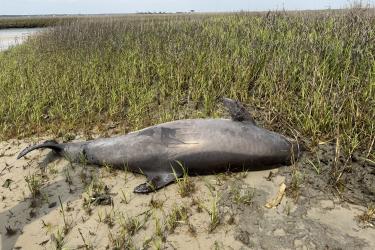On Earth Day, April 22, NOAA’s Teacher at Sea Program embarked on its 2023 field season. That morning, NOAA Ship Pisces departed Galveston, Texas, to survey reef fish in the Gulf of Mexico. On board was Missouri middle school teacher Julie Hayes, embedded as a member of the science team. Nine more educators are scheduled to sail this year on NOAA ships sailing from ports around the United States. Together, they comprise the remainder of the Teacher at Sea cohort originally selected to sail in 2020, but delayed by the pandemic.
Bringing the Ocean to Students
For Julie Hayes, the experience, 3 years in the making, is worth the wait. “I am beyond ready and can’t wait to share this experience with my family, friends, and students,” she writes in her blog. Julie teaches life science, ecology, and STEM at Macon R-1 Middle School in rural northern Missouri. In her classes, she helps her students relate to the environment around them, whether in their backyards, the surrounding farmland, or the nearby state park.
Connecting her students to marine environments, however, can be more of a challenge. “Since we are landlocked and far from the ocean, I try to bring the ocean to them,” she explains. For Julie, who once considered becoming a marine biologist, it’s important to help students understand that actions in their own community can impact ocean ecosystems. “We discuss how our farming practices in the Midwest can filter through the watershed, and end up in the mighty Mississippi River that meets the Gulf of Mexico.”
Bringing Teachers to the Ocean
Now, Julie is heading to the Gulf of Mexico herself. School is still in session, and her students are excited to follow along. First, they brainstormed questions for Julie to ask the scientists and crewmembers on her mission. Then they wrote personal encouragement letters for her to take on her journey and read while she is away.
Throughout the summer, nine additional educators from eight states (including Alaska!) will join NOAA missions. They will help scientists conduct fisheries, marine mammal, ecosystem monitoring, and hydrographic surveys around the country. Like Julie, these Teachers at Sea will write blogs and create lesson plans to share what they learn at sea with their students, schools, and communities.
This year’s field season complements last year’s successful return to operations. In 2022, the program sailed the first six of the teachers selected (but postponed) for 2020. Season highlights include the first two NOAA Teachers at Sea ever to sail on a Great Lake (Lake Erie, aboard NOAA Ship Thomas Jefferson), and a Teacher at Sea from Puerto Rico who wrote a bilingual English/Spanish blog. A fourth Teacher at Sea was the first to be featured in a NOAA Fisheries podcast.
NOAA’s Teacher at Sea Program immerses educators in the research that NOAA conducts to better understand and conserve ocean resources. These unique experiences provide schools around the country—from the coasts to the heartland—personal connections to NOAA’s science and stewardship. We’re excited to see what this season has on the horizon.




